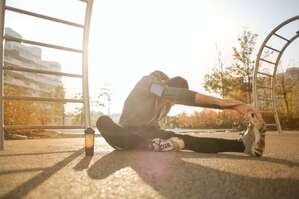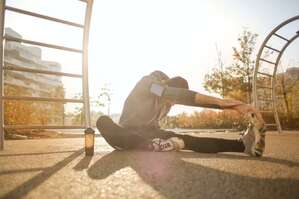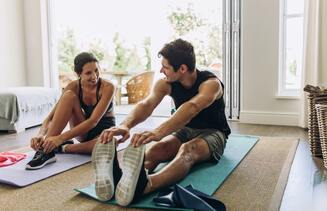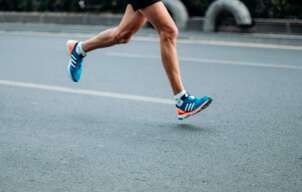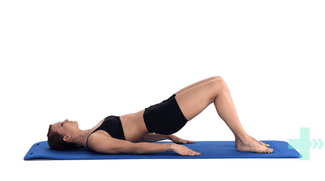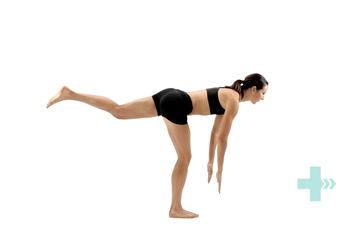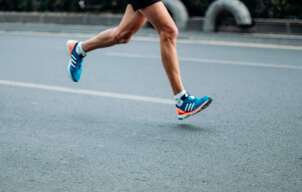|
Stretching has long played an important role in the world of sport and fitness, with many athletes stretching religiously before and after exercise in hopes of preventing injuries. More recently, this practice has been called into question with many people wondering if stretching really makes a difference to athletic performance. The answer, like most things, is not black and white, as we explore a little in this article. A brief introduction to stretching
Stretching is a type of movement that increases flexibility by lengthening muscle fibres to the end of their range. Stretching before and after exercise has been thought to reduce the risk of injury, improve athletic performance and reduce muscle soreness after exercise. The two most common types of stretching are static and dynamic stretching. Static stretching is when you lengthen your muscle and then hold that position for a period of time. Dynamic stretching uses movement and momentum of the body to stretch muscles to their end range, without holding the stretch at the end. What does the research say? Some research has suggested that static stretching before an activity can actually reduce power, strength and performance. However, these reductions were shown to be minimal and not noticed at all if the stretches were held for less than 45 seconds. It has also been found that stretching does improve flexibility but only for a short period of time. A few minutes after stretching, your joints move further, and with less resistance, so you may have improved flexibility immediately after stretching. Why stretch at all? One thing that is undeniable is that stretching feels great, with many people feeling more relaxed and reporting a rush of endorphins after a good stretching session. It is also difficult to test the long-term effects of stretching specific muscles showing abnormal tightness. A long-term static stretching routine will improve your overall flexibility, and this is thought to help prevent injuries, although the evidence is inconclusive. If you’re an athlete, the decision to stretch or not can be a personal one. A warm-up prior to intense exercise that includes some form of dynamic stretching is generally recommended for reducing injury risk, but of course is no guarantee. Strength and balance training may have a far greater impact on reducing injuries in the long term. Your physiotherapist is able to guide you on the best stretching advice for your individual activity and they may be able to identify some areas where improving your flexibility will help to reduce injuries and improve performance.
0 Comments
Being active is one the most important aspects of a healthy lifestyle and there are many different ways to get your heart rate up. No matter what your choice of activity is, there is always some risk of injury. In this article, we have listed some tips to help you prevent accidents and injuries. 1. Choose the right footwear
The correct footwear can go a long way in protecting your feet and ankles from injury and can even prevent serious accidents such as falls. Every activity places different demands on your body and tailoring your footwear to suit these stressors is a great strategy for preventing injuries. For example, basketball players often wear shoes with support that extends above the ankles to help protect against ankle sprains, while hikers require thick and supportive soles to cushion and protect their feet. Wearing shoes that are too large or have poor grip can lead to slips and falls, particularly when exercising in the outdoors. Your physiotherapist can guide you with the correct choice of footwear for your chosen activity. 2. Pace yourself When you start to see improvements in your fitness and strength, it can be tempting to push your limits to see just how far you can go. The danger in this is that often your tissues are still adapting to the increased demands of your new exercise regime. Increasing your weights, training time or running distances by too much too soon can lead to major setbacks. Give your body time to adjust and progress in a slow and steady manner. 3. Check your form and posture Checking your posture in the middle of a workout is probably the last thing on your mind, however poor form is a leading cause of injury in athletes. As an example, lifting weights when your spine is not in its optimal position causes many low back injuries. Taking a second to check your posture before starting a lift is highly recommended. 4. Seek professional advice Coaches and trainers are able to help you spot vulnerabilities and share their knowledge, helping you get the most out of your chosen activity. Often it is easier to prevent bad habits from forming than it is to break them once they are already in place. Invest in the advice of an expert, they can help you to avoid injuries as well as reach your peak performance. Your physiotherapist is able to identify weakness in your training technique, biomechanical vulnerabilities, tight and/or weak muscles and can help guide you through your recovery if an injury does occur. However, prevention of injuries is always preferable to treatment whenever possible. There’s no doubt that doing the right thing for your health can be difficult. Whether that involves eating healthier, exercising more, flossing your teeth or even doing your physio exercises, the best choice is not always the most comfortable. Once a habit has formed and become part of your routine, making the right decision for yourself can become a lot more straightforward. Getting to that point is easier said than done. Here are a few tips to help you reach your health goals...
1. Choose a friend to join you for accountability. One way to guarantee that you show up for an early morning gym session is to have a friend who you partner with. You might be comfortable sleeping in for yourself, but not so much when you have someone else you’re letting down. Sharing difficult tasks with a friend can make them more enjoyable and you can also set up competitions with them if you need a little extra motivation. 2. Combine tasks with an activity that you do like. Love a true crime podcast? The gym can be the time to catch the latest episode or even stream your favourite show. Anything you do that helps to increase the enjoyment of the activity you’re avoiding is going to help you get started. 3. Batch tasks to be more efficient. Are you trying to drink more water, floss and also complete your physio exercises? Why not do all three in the same sitting? Combining tasks can be a surprisingly effective use of time and a way to remind yourself to complete them. 3. Use positive reinforcement for good behaviour, rather than punishments. Many people will feel bad when they fail to reach their goals and try to restrict themselves in another area to compensate. It can be a much more effective motivation strategy to reward yourself after completing a task, rather than punish yourself for not doing it. 4. Get your foot in the door. Putting your shoes on can be the hardest part of going for a run. If you’re struggling to complete a task, sometimes all you have to do is tell yourself you only need to do five minutes. Once you’ve started quite often you’ll want to do more, but setting small goals can be the trick to getting started. Once a habit is in place, the easy part is to increase the intensity or length of time you’re doing it. It's believed that it takes 21 days of completing a task for a habit to be formed, where you will then do it automatically as part of your routine. For more tips and tricks on how to reach your health goals, speak to your physiotherapist. While there are many benefits to be gained from effective stretching, employing an improper technique can actually result in injury. Here are some tips and guidelines for you to follow when stretching... - Warm up first with an activity such as walking (at least 5 -10 minutes).
- Stretches should be pain-free. You should only feel tension or a tight feeling when stretching. If you feel a sharp pain, this means you're stretching too far. - Don't hold your breath while stretching, keep breathing to ensure the muscle tissues remain oxygenated during the stretch. - Stretch both sides. But if one muscle is tighter than the other, focus on it more until they're both in the same range. - Avoid bouncing at the end of the stretch because it may lead to injury. - Hold stretches for 20-30 seconds, if not longer. A 10 second stretch is not always enough to achieve a lasting effect. - Repeat the stretch 3-5 times with intermittent rest periods in between. - Make sure your body is aligned properly and observe good posture. When to Stretch? Traditionally, stretching has been encouraged before and after any kind of physical activity. However, recent studies show that there is no discerning difference between whether you stretch before exercise/sports or not, both in terms of performance and injury prevention. In some cases, researchers say that it's okay to omit the pre-event stretch since the post-event stretch is much more beneficial. Some of our everyday postures and activities can lead to certain muscles becoming tight while the others sit in a lengthened position. These habitual postures that lead to muscle imbalances then become more and more difficult to correct over time. Many therapists will suggest that stretching all muscles generically isn’t as beneficial as identifying which of your muscles are abnormally tight and developing a targeted stretching regime. Talk to your physiotherapist for advice regarding the best stretching program for your body type, posture and activity levels. We know many of the habits that shape our adult lives are set in childhood. Physical activity is important for a growing body as movement and weight bearing have a large impact on bone strength, muscle and tendon health. Here are some tips to make sure your child is staying as active as possible. 1. Find an activity that suits your child.
Children who are coordinated and excel in competition may find team sports both increase their self-esteem as well as keep them fit. For other children, being a part of a team can be uncomfortable. Less competitive children may prefer a sport where success is measured by improving on their own performance, rather than being compared to other children. Surfing, yoga, martial arts, dancing or gymnastics may be activities that suit your child if competitive and team sports cause them to be discouraged. 2. Do get injuries checked out by a professional and invest in proper rehabilitation. While children do bounce back quickly from injuries, they also may have difficulty expressing pain and discomfort. A niggling pain that won’t go away may cause your child to say “I don’t like sport” rather than realising that they are in pain. Some children may retain worries that they will hurt themselves again because of a previous injury and avoid exercise. Your physiotherapist can help to identify any issues that your child is having and help to resolve them. 3. Set fun and challenging goals for them to complete during their daily routine. As less children are walking and riding to school, try to find ways to fit extra activities into the day. Some fun examples include running a daily long jump competition in the back yard or adding a routine of age appropriate exercises, such as star jumps, hopping, balancing and running on the spot. You can make these exercises part of the night or morning ritual, just like brushing your teeth. There are many reasons to choose a form of cycling as a sport. Commuting to work by bike can help you conveniently find time for exercise, save money on transport costs and is a great way to exercise if you need to avoid excessive weightbearing. Biking injuries are quite common, but in many cases preventable. Here are a few tips from us to help you prevent cycling injuries and improve your performance. Don't neglect your upper body strength and trunk stability.
While cycling is a sport that predominantly uses the legs, it's a mistake to think that leg strength is the only thing that matters when it comes to biking performance. Increasing the strength, flexibility and balance of your upper body and trunk can actually reduce the amount of effort used to cycle and improve the efficiency of your pedalling. Focusing on your whole body fitness can both improve your riding performance and help to prevent the neck, back and shoulder pain that can come as a result of maintaining postures for extended periods. Yoga and Pilates are great complementary activities to help build upper body strength and stability while also counteracting the effects of prolonged flexed postures of the bike. Don't skimp on your helmet. A good quality helmet can mean the difference between a sore head and a life-changing injury. Helmets become less effective with each hit, as they can lose their shock-absorbing capacity even if they don't appear to be damaged. If in doubt after a crash, make sure you replace your helmet as it may help to save your life. Address aches and pains early. Due to the repetitive nature of cycling, overuse injuries are common. Ensuring your bike is set up correctly to minimise stress on your body while riding and paying attention to small niggles before they become bigger problems can help to identify and resolve issues early so that you can keep cycling without discomfort. Speak to your physiotherapist for more information on how to improve your performance and stay injury-free while biking. What is it? Shin splints are a painful condition of the lower leg, also known as Medial Tibial Stress Syndrome (MTSS), it is an overuse injury that causes pain along the inside of the tibia (shin bone). It occurs most commonly in runners, hikers and soldiers who march long distances. What are the symptoms?
Shin splints are typified by persistent leg pain, usually the inside of the shin, halfway down the lower leg. The pain might be felt during exercise or directly after. Some people experience a dull ache over their shin that lasts for quite a while after exercise stops, while for others the pain may be sharp and fade quickly. The pain is often progressive, becoming worse with shorter distances. Eventually, shin splints can severely impact activity levels as the pain becomes too severe to continue exercising. Shin splints can be extremely painful and very disruptive to activity levels. As the pain usually starts gradually and progresses many people find themselves unable to continue training. Shin splints may progress to stress fractures if not diagnosed early and managed effectively. How does it happen? Shin splints are predominantly seen in runners who increase their distances quickly, often while training for an event. Activities that require repetitive weight-bearing of any kind, such as marching or high impact sports have also been shown to cause shin splints. Although the pathology of shin splints is unclear, studies have been able to identify certain risk factors that may predispose someone to shin splints. These include... · An quick increase in activity level; · Improper footwear and support; · Higher BMI; · Training on hard or uneven surfaces; · Tight calf muscles; · Flat feet; · Increased external rotation range of the hips; · Females are more likely to develop shin splints than males; · Prior history of shin splints. How can physiotherapy help? The first step for your physiotherapist will be to address any contributing factors to your injury and help to adapt your training program to a level that is optimum for you. A period of relative rest may be recommended along with a targeted strengthening and stretching program for any weak or tight muscles. Switching to low-impact activities such as swimming, cycling and yoga may also help to maintain fitness during recovery. Your running technique may be analyzed and any training errors corrected. When getting back into your training routine, it is usually recommended that distances are not increased by more than 10% per week as this allows the tissues of the body to react to the increased demands and adapt accordingly. An essential component of physiotherapy treatment is your home exercise program. All physiotherapists know that patients who complete their exercises will have better outcomes from their treatment, however it can be difficult to find time to complete them. Here are a few tips that can help you to fit your exercises into your weekly routine. Plan when to complete them
Making a plan might sound simple, but the expression 'failing to plan is planning to fail' has some truth to it. Physiotherapy exercises are specifically targeted towards weak and tight muscles. The exercises are likely to be a little difficult and uncomfortable. Setting a particular time aside in advance to complete them can help you overcome any resistance to getting them done. Ask your physio to prioritise them Your physiotherapist might give you a combination of exercises to complete. If you're struggling to find time to complete them all, ask your physiotherapist to rank the exercises in order of importance, this can help you to make sure you complete the most important ones when you are short of time. Set triggers as reminders You can use small every day tasks as reminders to remind you to complete your exercises. Some examples include boiling the kettle, brushing your teeth or as a final task before getting into bed. Use positive reinforcement Combining a task you don't enjoy with one that you do is a great way to motivate yourself. You can either pair your exercises with something you love such as watching an episode of your favourite tv show or give yourself a reward once they are completed. Either way, the more positive associations you make with completing your home exercise program, the less barriers you make to completing them! Want more tips? Ask your physiotherapist for their top tips and tricks for fitting your exercise program into your day. If you've ever started a new hobby or activity and noticed your balance isn’t quite up to scratch, it can be quite a disturbing discovery. Balance is an important part of many activities and if it's not being challenged regularly, it's easy for it deteriorate without you noticing. What is balance?
Keeping your balance refers to a state where your centre of gravity is maintained over your base of your support, preventing you from falling. Your body is always working hard to keep this equilibrium without you realising it. Balance is controlled by many systems that work together, including the visual, vestibular, proprioceptive and musculoskeletal systems. What is proprioception? Proprioception refers to the awareness of your body’s position in space. The central nervous system gains sensory input from the muscles, skin and tendons and interprets this information, creating a sense of where your body is positioned. This is how you know your foot is flat and ready to take your weight when you step, without needing to look at it. You may not have heard of proprioception before, but it is vital to keep you from falling and can be improved. How can I test my balance? Your physiotherapist is able to assess your balance more extensively, however here are a few quick tests you can do at home to see if your balance can be improved. Stand with two feet together and close your eyes. Try again, this time standing on one foot with your eyes open. Close your eyes only once you have found a steady posture with your eyes open. To increase difficulty, stand on an uneven surface, like a pillow on the floor. Aim to balance for at least 30 seconds in each of these postures. If you can't have a chat with your physiotherapist and see if your balance can be improved. They will also be able to offer you some practical tips on how to reduce falls and injuries. Running is a great way to stay in shape, manage stress and increase your overall health. However, it’s not without potential drawbacks. While generally being a low-risk activity, there are a few injuries that commonly affect runners. As running is a repetitive impact activity, injuries can develop slowly and if left too long, then be difficult to treat. Here are three of the most common conditions faced by runners... 1. Runner’s Knee:
Runner's knee is a persistent pain on the inside of the knee caused by the dysfunctional movement of the knee-cap during movement. The knee-cap ideally sits in the centre of the knee and glides smoothly up and down as the knee bends and straightens, in a process described as tracking. If something causes the kneecap to track abnormally, the surface underneath can become worn, irritated and painful. The pain might be small to start with, however left untreated, can make running too painful to continue. 2. Shin Splints: Shin splints (medial tibial stress syndrome) is a common condition characterised by a recurring pain on the inside of the shin. While the cause of this condition is not always clear, it is usually due to repeated stress where the calf muscles attach to the tibia (shin bone). Why this becomes painful is likely due to a combination of factors that can be identified by your physiotherapist to help you get back on track as soon as possible. 3. Achilles Tendonitis (tendinopathy): The achilles tendon is the thick tendon at the back of the ankle that attaches the calf muscles to the heel bone. The amount of force that this tendon can absorb is impressive and is vital in providing the propulsive force needed for running. If the stresses placed on the tendon exceed its strength, the tendon begins to break down and become painful. Your physiotherapist is able to assess any factors that may contribute to this issue, including footwear, training errors and any biomechanical concerns. |
Categories
All
|

